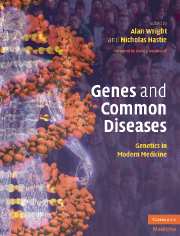Book contents
- Frontmatter
- Contents
- List of Contributors
- Foreword
- Section 1 Introductory Principles
- 1 Genes and their expression
- 2 Epigenetic modification of chromatin
- 3 Population genetics and disease
- 4 Mapping common disease genes
- 5 Population diversity, genomes and disease
- 6 Study design in mapping complex disease traits
- 7 Diseases of protein misfolding
- 8 Aging and disease
- 9 The MHC paradigm: genetic variation and complex disease
- 10 Lessons from single gene disorders
- 11 Environment and disease
- 12 Contemporary ethico-legal issues in genetics
- Section 2 Common Medical Disorders
- Index
- References
4 - Mapping common disease genes
Published online by Cambridge University Press: 17 August 2009
- Frontmatter
- Contents
- List of Contributors
- Foreword
- Section 1 Introductory Principles
- 1 Genes and their expression
- 2 Epigenetic modification of chromatin
- 3 Population genetics and disease
- 4 Mapping common disease genes
- 5 Population diversity, genomes and disease
- 6 Study design in mapping complex disease traits
- 7 Diseases of protein misfolding
- 8 Aging and disease
- 9 The MHC paradigm: genetic variation and complex disease
- 10 Lessons from single gene disorders
- 11 Environment and disease
- 12 Contemporary ethico-legal issues in genetics
- Section 2 Common Medical Disorders
- Index
- References
Summary
Introduction
What is “gene mapping” and why is it useful?
One of the goals of human genetics research is to understand genetic variation between people in their susceptibility to disease. From twin and family studies, and the study of Mendelian disease, it is clear that some traits and diseases “run in families” and that the reason for the increased disease risk of relatives of affected individuals is, at least in part, because of their genetic predisposition. Genetic variation in populations is caused by mutations that cause differences in DNA sequence and by other genome events in the germline, for example insertions, deletions, duplications and translocations of stretches of DNA. If these mutation events have an effect on a phenotype of the carrier, for example an increased risk of disease or an effect on a continuously varying phenotype (such as blood pressure or body mass index), then there will be an association between the genotype and the phenotype. Gene mapping aims to identify locations on the genome that are responsible for genetic variation and, ultimately, to identify which specific variants cause the observed effect. Gene mapping is useful because it leads to an understanding of the nature of genetic variation and the identification of variants and biological pathways that cause or predispose to disease. This knowledge can be used to develop drug targets or other treatments and in the future may be used for disease diagnosis or the assessment of susceptibility to disease.
- Type
- Chapter
- Information
- Genes and Common DiseasesGenetics in Modern Medicine, pp. 59 - 79Publisher: Cambridge University PressPrint publication year: 2007
References
- 1
- Cited by



